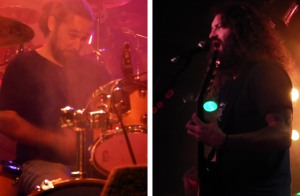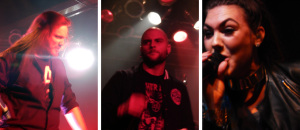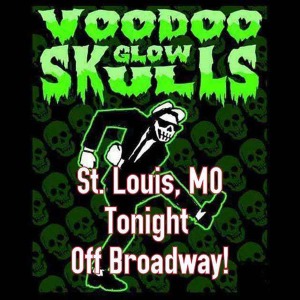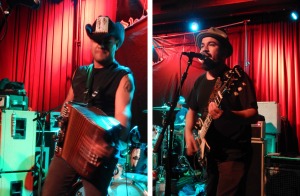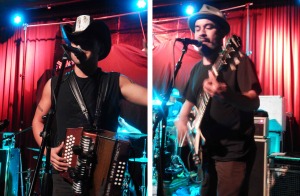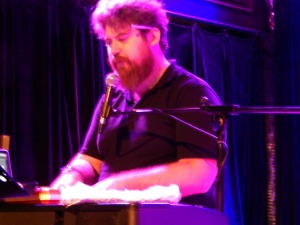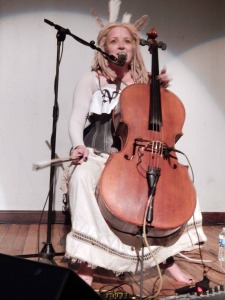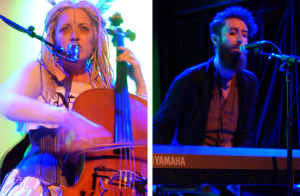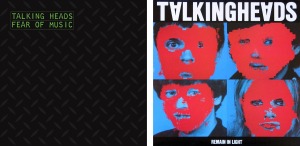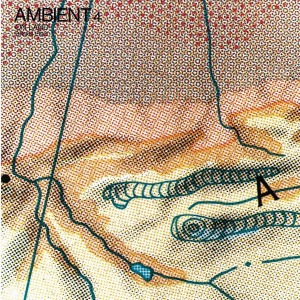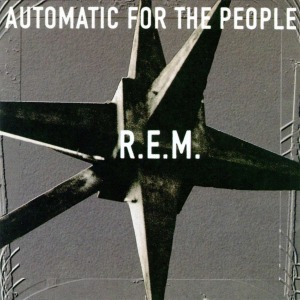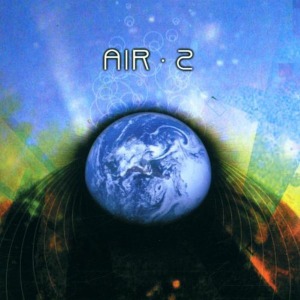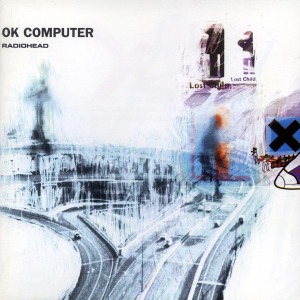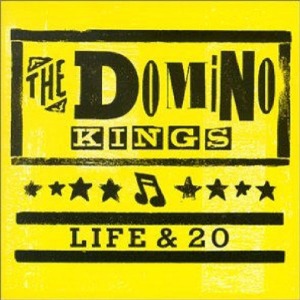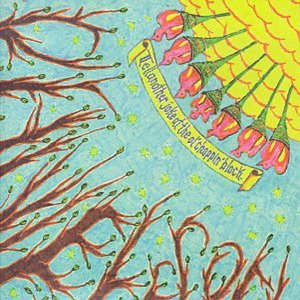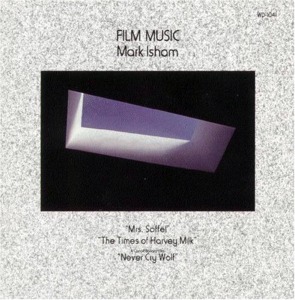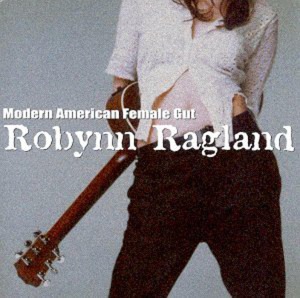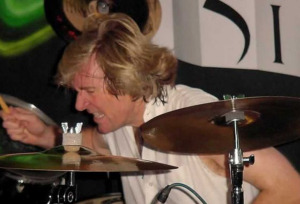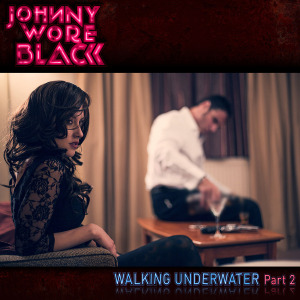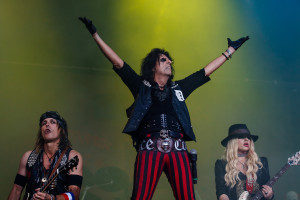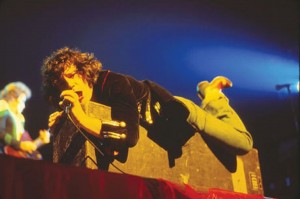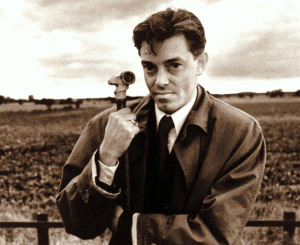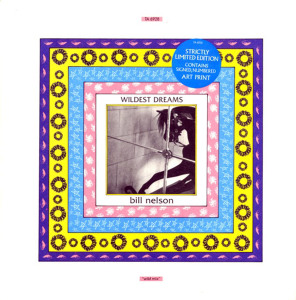(November 21, 2015; READY ROOM, Saint Louis MO)
So, this is the second metal show I’ve seen in the past five days and, like the Amaranthe show at Pop’s, this one had its fair share of drunken yahoos and intolerable idjits; in fact, several of the drunken yahoos and intolerable idjits from Pop’s were performing the same functions at the Ready Room. Even before the lights went down and the first band took the stage, a woman who seemed relatively sane five nights previous (her twelve year old son was with her then) was already so sloshed that she was slurring her words and was unable to navigate her way across the floor to the rest room, but we’ll get into more specifics as we go through the evening’s festivities, beginning with…

The Supermen, an unrepentant mish-mash of punk, metal, misogyny, soft-core porn, comedy and wrestling from the StL. This band is pure, mindless mayhem and their stage show had so much happening that it was hard to find a focal point; I’m sure that a majority of the males in attendance spent most of their time focusing on the barely-dressed dancer/dominatrix who, according to the Supermen’s Facebook page is called (Hail the New) Dawn and is listed as “Property.” For the ladies, there was Tiger Mask IV, the male counterpart to Dawn, who is the group’s “Lead Partier” and was, likewise, barely dressed, sporting a Luchidor mask, wrestling trunks and boots. The rest of the band have also adopted wrestling gear and names (Maxxx Loads, “the Prom King,” plays bass; Valiance Jack, “the Promiscuous Protomartyr,” plays drums; Jimmy All-Dick, “the Alpha Male,” plays guitar; Gaius Julius Sensei Almighty is the singer; and the “manager” is Osama Bin Erickson, the Dean of Debauchery). Musically, think early punk laced with liberal doses of Motorhead-style metallic speed; lyrically, look to bands such as the Cramps or Dwarves for like-minded reference points (translation: Don’t try to read too much into what’s going on with the Supermen; they don’t take themselves too seriously and neither should you). Even though the look and songs do, in fact, border on the cartoonish, don’t miss out on the fact that these guys are actually really good players. The band’s twenty-minute, ten song set included such instant classics as “White Women In Distress,” “Live Punk Sex Act,” “I Kill Everything I Fuck” and their call-to-arms anthem, “Blood, Honor and Pussy.” A fun time was had by all, except for a fellow cameraman, who was continually hit or shoved from behind by (surprise, surprise!) a drunken tool who would wander to the back of the room and then charge to the front, yelling, “Hey! Hey! Hey!” to whoever happened to be on stage at the time. Music reviews should not focus so much on the audience’s behavior, but when that behavior actually hinders your enjoyment of the music, it must be addressed (in an effort, hopefully, to curtail such incidents in the future for the enjoyment and safety of everyone involved).
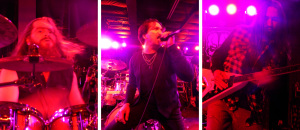
Another local act, Hung Like a Martyr (who, coincidentally, have opened for Doyle’s old band, the Misfits), offered more of a straight metal sound that was not unappreciated by yours truly. Bruce Morrison’s voice has a certain Vince Neil quality, but carries the emotional weight of a John Corabi (thus embodying both Crue singers in one), though the actual music was heavier than the Crue’s pop metal. The dual guitars of Erik Spiller and Paul Dontigney reminded me of the Phil Campbell/Wurzel two-pronged guitar attack of Motorhead’s mid-’80s to mid-’90s period… rough, fast and insanely melodic; the rhythm section of bassist Adam “Adamned” Fuchs and drummer Mark Nicol managed to keep things brutally heavy while never giving up their funky groove. The set built from the frustration of watching this country crumble under the weight of internal strife and increasing violence, as well as attacks from without, with the opening song, “Bent,” a battle cry that lets everyone know that we may be bent but we’re not broken; “Kill Your Own King” and “Watching the World Burn” are laments to the fact that America is so divided that we can seemingly no longer find a common ground on which to come together; “The Reaper” and “Nuclear Salvation” follow the same apocalyptic message. The final number, “Dead Body Dumptruck,” is basically a dark hymn to what we have to look forward to if we don’t get our act together: Death from within and annihilation from without, leading to a sort of NIGHT OF THE LIVING DEAD zombie apocalypse of rotting corpses in mass graves. The songs – while very much in the horror/science fiction vein – had an angry spark of truth, delivered with a conviction and energy that was hard to ignore… even the drunks and idjits behaved during the set. All of the tunes, aside from “Bent,” are from earlier incarnations of Hung Like a Martyr; with a new record eminent, I, for one, am excited to see where new vocalist Morrison leads the group, lyrically, from here.

Though I’m not really into the “Anti-Christ Superstar” imagery and lyrics of groups like Marilyn Manson, I must say that Element A440 serve up their version with something that Manson frontman Brian Warner could never offer: Talent. Add to that a genuine conviction for what they’re doing (a seemingly concerted effort to not just shock or offend for the sake of being shocking and offensive… I mean, this FEELS real coming from this group) and, whether you agree with their stance or not, you have the makings of a fiery, evil set of industrial metal that is hard to ignore. Where the band does appear to be pandering to the lowest common denominator is the over-the-top attempts to titillate with sophomoric pornographic lyrics and visuals; a shame really, as the horror and religious elements of their set are what drives the narrative. It would appear that vocalist Halo (who also does programming and plays guitar… at least in the studio) is the mastermind behind the look and sound of Element A440… he is the sole songwriter and, I would guess, the visual designer of the band’s appearance and onstage set-up; the set was structured with a smart ebb-and-flow at the beginning, eventually ramping up to a chaotic close with the entire band donning some of the creepiest half-masks this side of the original Slipknot… the only thing we didn’t see was Halo’s fire-breathing (a matter of strict fire laws and low ceilings, I would guess). The musicians – guitarist Graven, drummer Kat and bassist Katt – were tight and scalpel-sharp, delivering their brutal, misshapen pop with a glee that never quite matched Halo’s but… that didn’t keep them from trying, pushing each other (and their manic leader) to ever harsher heights of musical mayhem. The songs that had the most impact, for me, included “Dance Dead,” “Wasted,” “Godless,” “Freak” and, I suppose, “Porn Star,” though for different reasons than you would think. I would definitely like to see a full Element A440 headlining set with the group pulling out all of the musical and effects stops… perhaps outdoors at Pop’s? Naturally, the drunks were back from their sabbatical during the last set, as the “Hey! Hey! Hey!” guy was back, seeking the acknowledgment from the stage that would validate his coolness and, the seemingly sane mother from five nights ago was all but molesting a couple of young men in the front row.

With a new band, a new album and a tour with Glenn Danzig highlighting the last few years in the career of Doyle Wolfgang von Frankenstein, the Misfit guitarist is building on those successes with a headlining run through the States. Doyle (the man and the band) brought their ABOMINATOR TOUR to the Ready Room on the Saturday before Thanksgiving and absolutely destroyed! Doyle’s signature slash-and-burn style of guitar playing meshes well with the howling, growling vocal gymnastics of Alex “Wolfman” Story (he of Cancerslug fame) and, with bassist Left Hand Graham and drummer Brandon Pertzborn laying down a rhythmic bottom end denser than a graveyard fog, the crowd hung on every note, every scream. The set, as may be expected, was heavy on music from ABOMINATOR (ten tunes) and classic Misfits (eight songs). In fact, until the final four numbers, the group alternated three Doyle songs with three Misfits numbers; that pattern was broken up by a cover of KISS’ “Strutter,” which we’ll discuss later.

Kicking off with “Abominator,” the band proved their metal mettle (sorry… couldn’t resist), with Doyle already stalking the stage and hammering his guitar mercilessly. As much as I enjoyed Story’s vocals throughout, it wasn’t until the fifth song, the classic punk of “Ghouls Night Out.” I suppose now is as good a time as any to mention that our screamer did change up the act a bit for the headliners; his mantra now became, “Doyle! Doyle! Hey, Doyle,” which at the beginning of the set was directed at Alex Story. The inebriated Mom, cajoled and egged on by this goof between bouts of yelling his lungs out at the band, even made it onto the stage, a little to the right of Graham, where she just kinda swayed to the music until the tour manager took her arm and led her off, at which point, I assume, she began cozying up to the brothers who had been fending her off the entire evening. So, anyway, after “Skulls” (from the WALK AMONG US album), it was back to new material, including the wickedly awesome “Dreamingdeadgirls” and “Love Like Murder.”

The musical merry-go-round continued with three of the best tracks from EARTH AD, “Green Hell,” “Bloodfeast” and “Devilock.” Now, of course, hearing all of the great Misfits songs, when I sat down with Doyle after the show, I had to ask the question that has been on every Fiend’s mind since the original group broke up nearly 35 years ago: “Are the reunion rumors true and, if so, where do things stand now?” Doyle tells me, “I’m workin’ on it. I’ve got two fuckin’ bulls to deal with, ya know? One dogs lookin’ this way, one dogs lookin’ that way and this guy’s sayin’, ‘What do you want from me?’” What more can we hope for? Well, for one thing, a second album from Doyle, the band but, more immediately, the final round of ABOMINATOR songs, including the heavy, atmospheric “Mark of the Beast,” and the graveyard mysticism of “Cemeterysexxx” and “Drawing Down the Moon.” This was the point where the guys broke the cycle, tearing into “Strutter.” It’s also the point that the two drunks actually managed to get Doyle’s attention; the woman was attempting to lift her shirt up, an occurrence that the gentleman just couldn’t let pass without alerting the guitarist: “Hey, Doyle! Doyle! Doyle! Look at these!” In mid-solo, without missing a beat, Doyle replied, “I don’t wanna see those nasty old things.” Crest (breast?) fallen, the duo were utterly lost, put in their places by the one guy in the whole building you didn’t want to cross. With a smirk on his face, Alex introduced the final two – and possibly the two most well-known – Misfits numbers, “Last Caress” and “Die Die My Darling,” which has attained legendary status among fans and punks everywhere. Closing with “Hope Hell Is Warm,” Doyle, Alex, Brandon and Graham left the crowd with ringing ears and memories of a great night of punk and metal.

Before leaving this review, I should probably explain why I spent so much time relating the actions of two very drunk people. The reasons are really simple: First, your actions made you a part of the show to the group of people around you, ruining what may have been their only night out for the entire month (or longer… considering the economy, live shows are very much a luxury nowadays). Second (and most important), there is no way that being fall-down drunk before the show even started can be construed as “just having fun,” miss… you have a serious problem that could endanger your life; please, take your actions into consideration, as you have a twelve year-old son to think about… how would you react if a stranger old enough to be his mother spent the night hitting on him? Plus, to both of you (and anyone else who decides to drink to excess), I don’t want to be on the road, worrying if you’re behind the wheel of one of the vehicles in my general vicinity. I understand that we all need a little release from time to time, a chance to let go and have a good time but, please, remember that there are others who have to put up with you and your drunken shenanigans and… please, don’t be the fatal statistic who crashed and burned on their way home from a killer night of Rock ‘n’ Roll.




